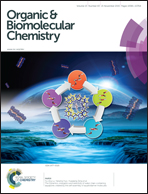Planar–rotor architecture based pyrene–vinyl–tetraphenylethylene conjugated systems: photophysical properties and aggregation behavior†
Abstract
Four pyrene–vinyl–tetraphenylethylene based conjugated materials were synthesized and characterized by FT-IR, NMR, and mass spectroscopy. The photophysical (including absorption, fluorescence, and fluorescence lifetime) and aggregation properties in tetrahydrofuran were investigated. The photophysical and aggregation behavior depends on the spacer, substituent, and also the architecture (mono or tetra-branched) of the molecule. The vinyl spacer mono-branched compound is aggregation induced emission (AIE) active (αAIE = ∼6). Vinyl spacer tetra-branched compounds are AIE inactive, but their emitting efficiency is good in both solution (Φfl = 63%) phase and in the aggregated state (Φfl = 43%). Phenylvinyl spacer tetra-branched compounds emit light strongly in solution (Φfl = 92%), but not in the aggregated state (Φfl = 8%). They are shown to be thermally stable and emit light in the green region (500–550 nm). The results of cyclic voltammetry measurements of these materials showed irreversible oxidation waves, and have high HOMO energy levels (−5.66 to −5.53 eV).


 Please wait while we load your content...
Please wait while we load your content...